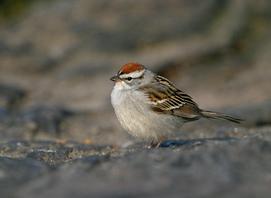CHIPPING SPARROW VA-15
Yorktown National Battlefield, Yorktown, Virginia & vicinity (Jamestown Beach Campground, Jamestown, Virginia)
May 5, 5:48 a.m.
Sunrise at 6:07 a.m.
Here is the second chipping sparrow in dawn mode, with songs from 1 1/2 to three seconds long, delivering about 11 per minute. How fascinating that the songs of this male look almost identical in sonagrams to those of his neighbor (VA-14).
And how do I know I have two males here with essentially identical songs and not one male who's moving around? Let me count the ways:
I can hear the other male in the background of this recording, and in the sonagrams I can see how similar the songs of the two males are.
This male sings 14 notes per second, the neighbor only 13 notes per second, so the songs differ slightly.
- The behavior of the two males differs, in that this male sings 11 songs per minute that are 1.5 to 3 seconds long, while the neighbor sings at almost three times that pace, delivering far shorter songs that are 1/2 to one second in duration.
Here is the essence of chipping sparrow, illustrating how these sparrows learn their songs. Each male, either during his hatching summer or the following spring, memorizes and sings a song from one neighboring adult male. Given how similar the songs of these two birds are, it is likely that one of these males learned his song from the other bird.
Background
Another chipping sparrow (the male in VA-14), eastern bluebird, Carolina wren.

Photo by John Van de Graaff
